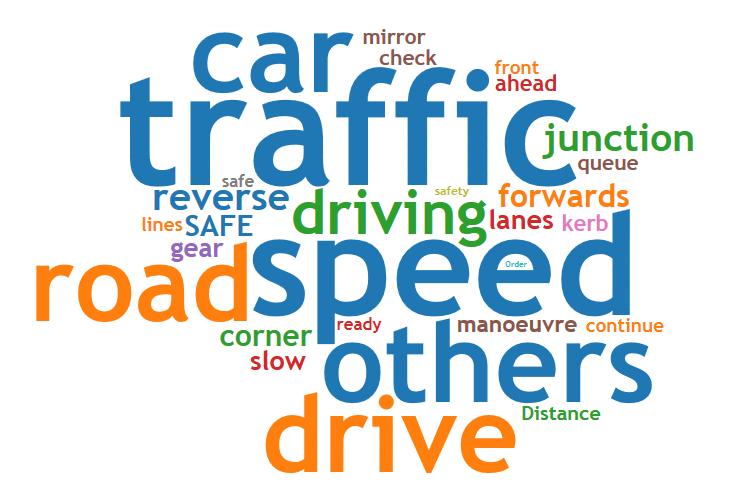Words
|
I remember my own instructor using certain words in very odd ways. "Hazard", for example, made me think only of toxic waste or kitchen knives; it seemed too much for a quiet T-junction or just a parked car.
I didn't have enough life-experience to see how far each word 'went' and the limits of what it described. Only after some years' driving did I understand why he used them as he did. |
And after that, these technical words made much more sense. I saw why sequences make sense, even when they seem fussy. "Hazard" really does mean "something that puts you at more risk than usual" (i.e. than when you're going perfectly straight, on a flat, open road with perfect visibility, perfect weather, and no-one else around).
Below are some definitions, so you'll know what the examiner means. (If viewing on a smartphone, see this page instead). |
|
road
road user new road end of the road pavement lane position drive ahead dead end curb / kerb camber bend corner control hazard safe convenient vulnerable efficient manøuvre oncoming give way priority observation progress hesitation planning anticipate defensive eco-safe driving carriageway dual-carriageway motorway |
Where people with a licence are allowed to drive cars, to ride bikes / motorbikes, or walk
People moving along or across the road, or sitting in or on a vehicle (including bike) on it The road you're about to drive into Where your road doesn't continue forwards (so you have to turn a corner) The strip of hard surface alongside a road, where pedestrians can walk away from traffic The part of the road to drive along, parallel to others going the same (or opposite) way Where you are on the road compared to its SIDES, rather than along it (= latitude, not longitude) A strip of land leading off a public road to private land or a parking space In front of your car, going forwards, without turning into a side-road A road which you can't get out of without going back the way you've come A border of stone, raised or at ground level ("dropped") between pavement and road The way the road slopes towards the kerb on each side, to drain water away to the gutters Any curve in the road, so that it deviates from going in a straight line The turn you have to make to go into a new road leading off from the one you're on Having your eyes & brain, feet & hands, working to keep the car doing only what you want Anything that might make you change speed or direction As sure as you can be that you've minimized the chance of risk or injury to you and others Not getting in the way of any other road user who might want to continue on their journey Being at risk (often, walkers and cyclists, who aren't travelling in a metal box like you !) Make best use of space (and time) on the road to maximize safety (minimize disruption) Adjusting the car's position, often involving reverse or pointing it the opposite way Road users coming towards you, from ahead Allow a road user coming toward you, along the new road, or crossing your path, to go first The legal right of someone else on the road to move off, or go in front of you, first Looking, so you know what's around you before you change speed or direction Getting to where you need to go, using the maximum SAFE speed Stopping or slowing down, where you shouldn't need to (if you're planning ahead) Working out what WILL BE happening in the next few seconds, so you can get ready for it Imagining what could happen (in the road ahead) Driving in a way that "absorbs" mistakes which other road users may make Using the least fuel (and causing least wear to brakes and car's mechanical parts) An older word for "road", from a time when horse-drawn carriages followed set routes Where each direction of traffic is separated by fence, grass, or kerbs; not just white lines. (Note: NOT a description of how many lanes of traffic can go each way Special high-speed dual-carriageway, with emergency provisions, fewer junctions, and usually 3 lanes |
